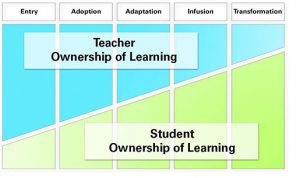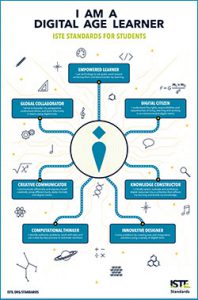
We spend a great deal of time of each week speaking with school and district leaders who are considering adopting the Technology Integration Matrix (TIM) and TIM Evaluation Tools. Invariably, the conversation comes around to questions about how the TIM relates to models and standards they are already committed to. Typical questions include:
- Does the TIM “align” with the ISTE Standards? We’re committed to meeting them.
- Will implementing the TIM help our students to achieve higher levels on Bloom’s Cognitive Taxonomy?
- We’ve got some folks in the district really sold on TPACK and others encouraging us to adopt TIM. Can the two play well together?
- We’ve been using SAMR with teachers new to tech. Do the four SAMR levels map to the five TIM levels?
Over the next several months, I plan to address how the TIM relates to the ISTE Standards, Bloom, TPACK, and SAMR.
Today, we start with ISTE.
No organization has done more to describe the role of technology in education than ISTE. The International Society for Technology in Education, ISTE, has published standards for many different stakeholder groups, including students, educators, administrators, and coaches. These are parallel sets of standards, so you have the ISTE Standards for Educators and the ISTE Standards for Students and they cover the same domains so that you can go from one to the other. The ISTE standards are extensive and they provide a host of resources to support effective technology integration.
Relationship between ISTE Standards and the TIM
The ISTE Standards are, well, standards. They’re aspirational. They describe (in the case of the educator and student standards) what educators or students should be able to do. For example, students “articulate and set personal learning goals,” “build knowledge by actively exploring real-world issues,” or “choose the appropriate platforms and tools.” Likewise educators “set professional learning goals,” “design authentic learning activities,” or “foster a culture where students take ownership of their learning.” Standards are more of a destination than a roadmap.
Implementation frameworks, on the other hand, can be thought of as the means to an end. In the case of the Technology Integration Matrix, the purpose is to help educators plan and implement lessons that more effectively lead to the desired student outcomes.
The original ISTE Standards (then known as the NETS) are in the TIM’s DNA. In the early 2000s, three factors came together leading to the creation of the TIM: A statewide need for a common vocabulary around technology integration, emerging doctoral research at USF, and a leading Florida district that came to us saying, “We love the NETS, but need something to help teachers better utilize them in their classrooms.”
That is not to say that the TIM is specifically aligned to any version of the ISTE Standards. The TIM and ISTE standards have each gone through revisions and expansions over the years. However, both the TIM and ISTE Standards draw from the same pool of education research, and so share many similarities. Both the TIM and ISTE Standards focus on pedagogy rather than technology itself. And both the TIM and ISTE Standards reflect substantial input from experts and practitioners in the field. As a result, they are largely complementary.
Underlying Themes
 If I were to identify the main theme underlying the ISTE Standards for students and educators it would be, “Empowering students to take ownership of their learning.” That is also the major underlying dimension of the TIM. We often use this graphic to show the increased student ownership of learning as one moves from left to right on the TIM. The TIM levels move from the teacher initially calling the shots, to allowing students conventional use of technology, to giving students freedom to explore and adapt technology, to encouraging creative and innovative use of technology to solve authentic problems.
If I were to identify the main theme underlying the ISTE Standards for students and educators it would be, “Empowering students to take ownership of their learning.” That is also the major underlying dimension of the TIM. We often use this graphic to show the increased student ownership of learning as one moves from left to right on the TIM. The TIM levels move from the teacher initially calling the shots, to allowing students conventional use of technology, to giving students freedom to explore and adapt technology, to encouraging creative and innovative use of technology to solve authentic problems.
Additional themes underlying the TIM include:
- Instructional Focus on Tools vs Instructional Focus on Content
- Procedural Understandings vs Conceptual Understandings
- Simple vs Complex Use of Technology Tools
- Conventional vs Innovative Use of Tech Tools
For more about the themes underlying the TIM, visit the post, The Invisible Technology Integration Matrix.
 A helpful summary of the main themes in the ISTE Standards for Students can be found in the adjacent poster created by ISTE for classroom use:
A helpful summary of the main themes in the ISTE Standards for Students can be found in the adjacent poster created by ISTE for classroom use:
Empowered Learner: I use technology to set goals, work toward achieving them and demonstrate my learning.
Global Collaborator: I strive to broaden my perspective, understand others and work effectively in teams using digital tools.
Digital Citizen: I understand the rights, responsibilities and opportunities of living, learning and working in an interconnected digital world.
Creative Communicator: I communicate effectively and express myself creatively using different tools, styles, formats and digital media.
Knowledge Constructor: I critically select, evaluate and synthesize digital resources into a collection that reflects my learning and builds my knowledge.
Computational Thinker: I identify authentic problems, work with data and use a step-by-step process to automate solutions.
Innovative Designer: I solve problems by creating new and imaginative solutions using a variety of digital tools.
Even more to the point are the “look-fors” published by ISTE for education leaders:
Students are applying technology for problem-solving activities that are real-world, authentic or relevant.
Students showcase their design thinking process and explain the steps taken to get there.
Students are creating intellectual or creative works and customizing the media and content to their audience.
Teacher and students are co-learning, exploring and experimenting with technology and digital tools and resources.
Students are working in project teams and collaborating with people locally and globally beyond the classroom walls.
When stated in this manner, it is quite easy to see the relationship between the ISTE Standards and the TIM characteristics of Active, Collaborative, Constructive, Authentic, and Goal-Directed Learning. In short, using the TIM as an implementation framework helps teachers design lessons that better support goals as expressed in the ISTE Standards for Students. Simultaneously, the ISTE Standards enrich and enhance a teacher’s understanding of the TIM descriptors. It’s a two-way street that’s a win for our students.
Roy Winkelman is a 40+ year veteran teacher of students from every level kindergarten through graduate school. As the former Director of FCIT, he began the Center's focus on providing students with rich content collections from which to build their understanding. When not glued to his keyboard, Dr. Winkelman can usually be found puttering around his tomato garden in Pittsburgh.
